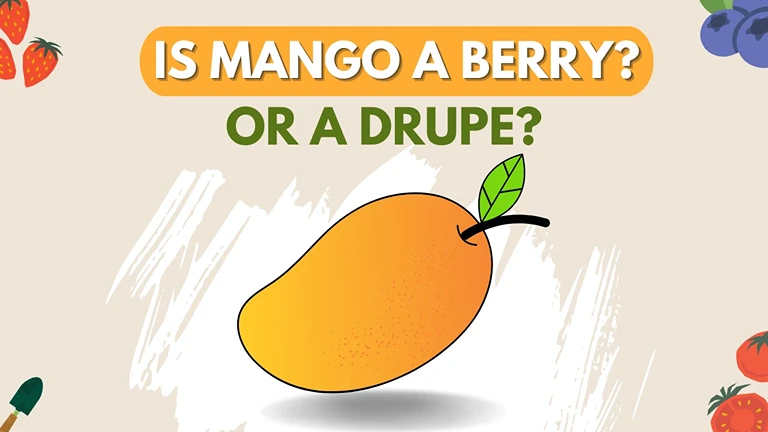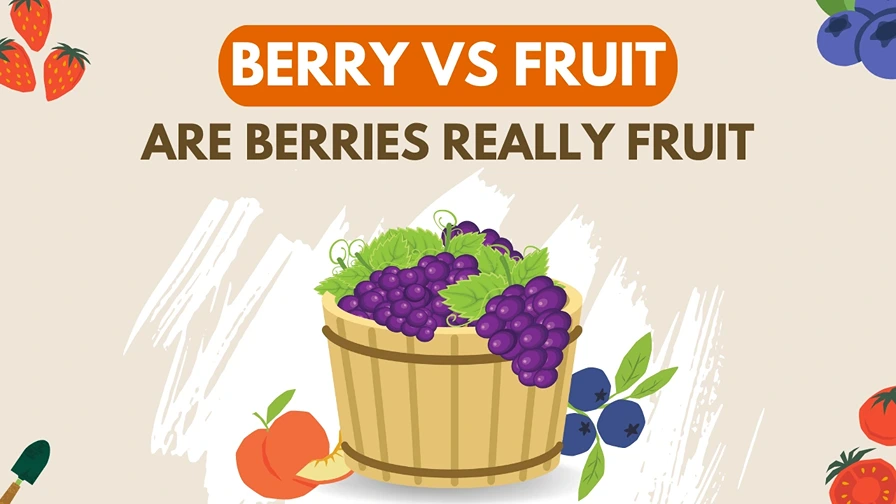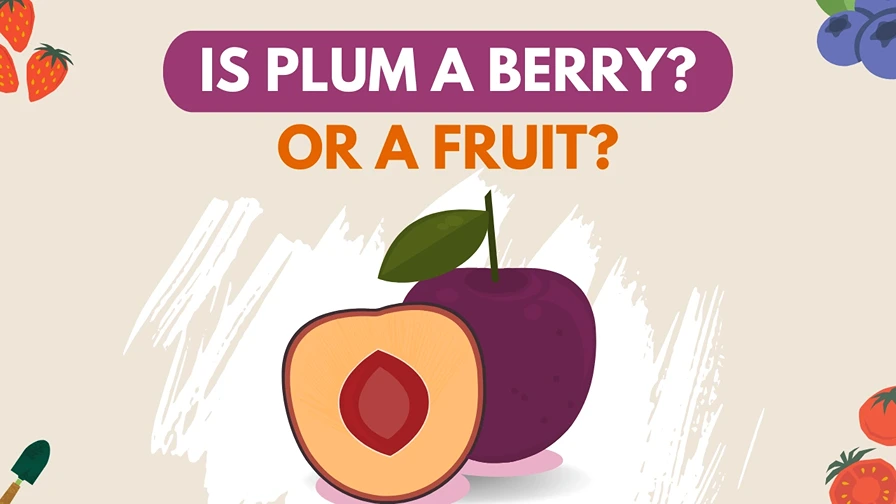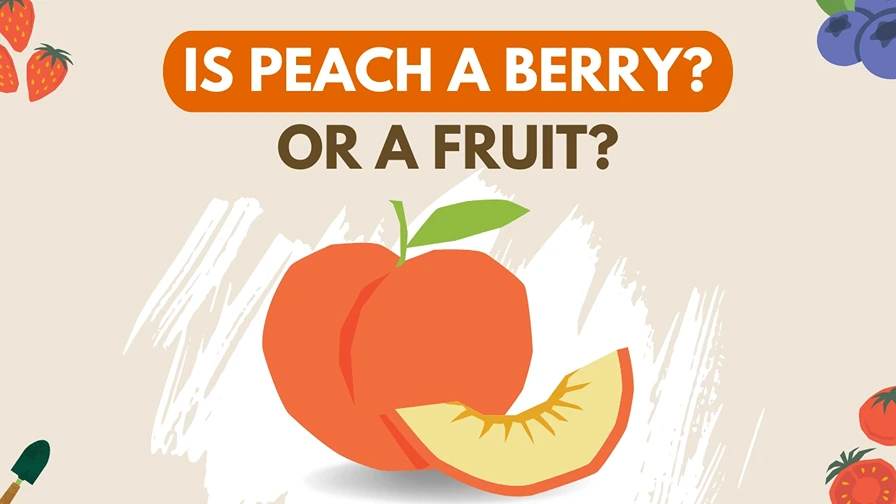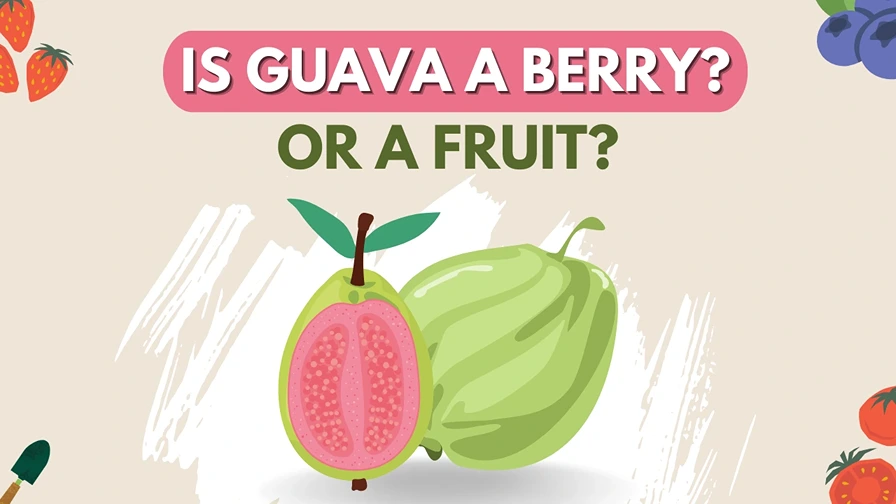Mango, a tropical fruit cherished for its delicious flavor, vibrant color, and juicy pulp, has always been a subject of curiosity when it comes to its botanical classification. Many people wonder: is mango a berry or a drupe? The diverse characteristics of this tropical fruit often lead to confusion.
Contrary to popular belief, mango is not a berry but a drupe fruit (stone fruit). So, why is mango classified as a drupe and not a berry?
Let’s delve into the classification of mangoes and gain a proper understanding of the berry vs fruit debate.
What is Mango?
Mango, scientifically known as Mangifera indica, is a tropical fruit that holds a special place in the hearts and taste buds of people around the world.
Originating in South Asia, where it has been cultivated for over 4,000 years, mangoes have become synonymous with sun-kissed tropical climates and abundant flavors. The mango fruit is celebrated for its unique combination of deliciously sweet and juicy flesh, which comes in a variety of vibrant hues, including golden yellow, orange, and even red.
Its luscious taste and aroma make it a true tropical delight.
The mango tree, a member of the Anacardiaceae family, is an evergreen tree that can grow up to 100 feet tall. It boasts a dense canopy of glossy leaves, providing shade under the scorching sun. The tree produces beautiful clusters of small, fragrant flowers that eventually give way to the development of the mango fruit.
Varieties
One of the most captivating aspects of mangoes is the incredible diversity of varieties available. Each mango variety has its distinct characteristics, ranging from flavor and texture to shape and size. Some popular mango varieties include Alphonso, Kent, Tommy Atkins, and Ataulfo, among many others.
Each variety has its own loyal following, with people passionately advocating for their favorite.
Cultural Significance
Mangoes hold immense cultural and culinary significance in many regions of the world. They have been incorporated into various cuisines, making their way into salads, salsas, smoothies, desserts, and even savory dishes.
The tantalizing taste and versatility of mangoes have made them a beloved ingredient in culinary creations, bringing a burst of tropical flavor to every bite.
Nutritional Benefits
Beyond their delectable taste, mangoes offer a range of nutritional benefits. They are rich in vitamins and minerals, particularly vitamin C and vitamin A, which contribute to a healthy immune system and good vision. Additionally, mangoes are a great source of dietary fiber, promoting digestive health and aiding in satiety.
The popularity of mangoes has transcended borders, and today they are widely cultivated and enjoyed in tropical and subtropical regions worldwide.
Now, let’s delve into the anatomy of a mango, examining its physical features and structure to gain a deeper understanding of this tropical fruit.
The Anatomy of Mango
To truly understand the nature of mango, it is essential to explore its anatomy and uncover the unique features that make it such a fascinating fruit.
- The Skin: Nature’s Protective Barrier
At first glance, a mango appears as a delectable orb of vibrant color and an enticing aroma. But let’s delve deeper into its physical structure to uncover its secrets.
The outermost layer of mango is the skin, also known as the peel. The skin can vary in color and texture depending on the mango variety. Some mangoes have smooth, waxy skins, while others may have a slightly rough texture. The skin acts as a protective barrier, shielding the fruit’s inner flesh from external elements.
- The Succulent Flesh: A Tropical Delight
Beneath the skin lies the succulent flesh, the part we all eagerly anticipate biting into. Mango flesh is soft, juicy, and typically a vibrant shade of yellow, orange, or even red.
The texture of the flesh can vary between mango varieties, ranging from fiberless and buttery to slightly fibrous. Regardless of the texture, the flesh is where the sweet and tangy flavors reside.
- The Central Core: Housing the Seed
As we venture further into the mango, we encounter the central core, which houses the seed. The seed, often referred to as the stone or pit, is relatively large and flat, taking up a significant portion of the fruit’s inner space. The seed is surrounded by the flesh and provides structural support to the fruit.
- The Seed: Hidden Potential
Now, let’s focus our attention on the seed or stone. The mango seed is flat and large, typically elongated and covered in a tough, woody shell.
It is important to note that the seed is not edible and should be discarded. However, it is worth mentioning that mango seeds have been used in traditional medicine and certain culinary applications in some cultures.
Let’s explore the characteristics of berries and drupes, comparing them to the anatomy of a mango to decide whether it is a berry or drupe
What is a Berry?
In botanical terms, a berry is a fleshy fruit that develops from a single ovary, typically with multiple seeds embedded in the fruit’s flesh.
Let’s explore the characteristics of berries to gain a clearer understanding:
- Fleshy Fruit: Berries are known for their fleshy nature, which means the fruit’s ovary wall is thick and succulent.
- Single Ovary: Berries arise from a single flower with a single ovary. The ovary contains one or more carpels, which are the female reproductive parts of the flower.
- Multiple Seeds: Most berries contain multiple seeds, which are embedded within the flesh of the fruit. These seeds are produced from the ovules within the ovary.
- Soft Texture: Berries typically have a soft and juicy texture, making them pleasant to bite into.
- Variety of Colors: Berries come in a wide range of colors, including red, blue, purple, black, and even yellow or green.
Is Mango a Berry?
The question of whether mango qualifies as a botanical berry has intrigued many fruit enthusiasts. To address this query, we must examine the defining characteristics of berries and compare them to the attributes of mangoes.
- Fleshy Fruit: Berries are known for their fleshy nature, with a thick and succulent ovary wall. Mangoes exhibit this fleshy characteristic, as their fruit flesh is soft and juicy.
- Single Ovary: Botanical berries originate from a single flower with a single ovary. In the case of mangoes, they develop from a single flower with a single ovary, aligning with this aspect of the berry classification.
- Multiple Seeds: Most berries contain multiple seeds embedded within the fruit’s flesh. Here lies a key point of divergence for mangoes. Unlike berries, mangoes typically have a single large seed, which does not conform to the multiple-seed requirement.
- Soft Texture: Berries generally possess a soft and juicy texture. Mangoes share this attribute, as their succulent flesh offers a delightful mouthfeel.
- Variety of Colors: Berries exhibit a wide range of colors, including red, blue, purple, and black. Mangoes, with their vibrant hues of yellow, orange, and red, display a color palette that aligns with the diversity found in berries.
Considering these defining characteristics, we can conclude that mango does not align with berry. While mangoes are fleshy and possess a single ovary, they differ in terms of seed count. Mangoes usually have a single large seed, rather than multiple seeds typically associated with berries.
This discrepancy in seed count places mangoes outside the botanical definition of a berry.
Let’s explore the actual classification of mangoes and delve deeper into the scientific perspectives that make mango a drupe fruit.
What is a Drupe?
To further explore the botanical classification of mango, we must examine the characteristics of drupes.
A drupe fruit also known as stone fruit is a type of fruit characterized by having a fleshy outer layer (exocarp), a hard or stony inner layer (endocarp) surrounding a single seed, and a middle layer (mesocarp) between the exocarp and the endocarp. The endocarp protects the seed, while the fleshy exocarp is often eaten or used for propagation. Examples of drupe fruits include peaches, plums, cherries, and coconuts.
Let’s delve into the defining features of drupes:
- Single Seed: Drupes contain a single seed or stone, which is encased within a hardened endocarp or pit.
- Fleshy Exocarp: The outermost layer of a drupe is the exocarp, which is typically thin and fleshy.
- Juicy Mesocarp: The mesocarp, or middle layer, is soft, juicy, and often the part that is consumed.
- Hard Endocarp: Surrounding the seed, the endocarp is tough and woody, protecting the seed inside.
- Variety of Sizes and Shapes: Drupes come in various sizes and shapes, ranging from small berries to larger fruits like peaches and plums.
Examining the characteristics of drupes, we can assess whether mango aligns with this classification.
Let’s explore further the debate surrounding mango classification and delve into the scientific perspectives that shed light on this intriguing topic.
Is Mango a Drupe?
To determine if mangoes align with the characteristics of drupes, we need to explore the defining features of this fruit type and compare them to the attributes of mangoes.
- Single Seed: Drupes are characterized by having a single seed or stone, which is enclosed within a hard, woody endocarp. In the case of mangoes, they possess a single large seed, meeting this criterion of drupes.
- Fleshy Exocarp: Drupes typically have a thin and fleshy outer layer called the exocarp. Mangoes exhibit this feature, as their skin or peel is indeed fleshy.
- Juicy Mesocarp: The mesocarp of a drupe is soft and juicy, and forms the edible part of the fruit. Mangoes align with this attribute, as their succulent flesh is similar in texture and juiciness.
- Hard Endocarp: Drupes have a hard, stony endocarp that surrounds and protects the seed inside. Mangoes differ in this aspect, as their endocarp is fibrous and not woody. However, it’s important to note that the fibrous endocarp still provides protection to the seed within.
- Variety of Sizes and Shapes: Drupes come in various sizes and shapes, ranging from small fruits like cherries to larger ones like peaches. Mangoes fit into this category, as they exhibit a diverse range of sizes and shapes depending on the variety.
Considering these characteristics, we can conclude that mangoes share several similarities with drupes.
Mangoes have a single seed, a fleshy exocarp, and a juicy mesocarp, and exhibit a variety of sizes and shapes. Although mangoes differ in terms of the endocarp texture, their fibrous covering still serves the purpose of protecting the seed.
All of these similarities make mango a drupe fruit (stone fruit).
In the following sections, we will delve into the scientific perspectives and research that shed further light on the classification debate surrounding mangoes.
The Botanical Verdict
By delving into the characteristics of berries and drupes and comparing them with the traits of mangoes, we can definitively determine how mangoes are classified in the botanical world.
While mangoes do share some similarities with berries, like having a juicy fruit and originating from a single ovary, what sets them apart is their large, single seed. This is unlike berries, which typically have multiple seeds.
However, the same large seed of a mango surrounded by juicy flesh and an outer layer classifies it as a drupe.
So, from a purely botanical standpoint, mangoes are not considered berries but rather fall into the category of drupes (stone fruit).
Let’s delve into the cultural significance, culinary uses, and health benefits of mangoes.
Mango’s Culinary Classification
While the botanical classification of mangoes may remain debatable, their culinary classification provides further insight into how these delicious fruits are regarded in the world of cooking and gastronomy.
- Mangoes are commonly considered tropical fruit in the culinary realm.
- They are known for their sweet and tangy flavor, luscious texture, and vibrant colors.
- Mangoes are versatile and can enhance a wide range of dishes.
- They are used in sweet preparations like fruit salads, smoothies, and desserts.
- Mangoes add tropical goodness to salsas, chutneys, and relishes, balancing heat and adding freshness.
- Mangoes are commonly used in Asian cuisine, especially in dishes from India, Southeast Asia, and the Caribbean.
- They are used in curries, stir-fries, and rice dishes to add their distinct flavor and aroma.
- Mangoes can be processed into forms like pulp, puree, nectar, dried slices, or powder.
- Processed mangoes are used in baking, ice cream making, and beverages.
- Mangoes elevate both sweet and savory dishes, infusing them with a tropical essence.
- They are beloved in diverse cuisines worldwide for their unique flavors and textures.
Conclusion
In the quest to determine whether the mango is a berry or a drupe, we have explored the botanical, culinary, and scientific perspectives surrounding this intriguing fruit. While mangoes exhibit certain characteristics of berries, it aligns perfectly with the classification of drupes.
The fleshy exocarp, the juicy and tasty mesocarp, and a hard seed in the middle make mango a drupe (stone fruit).
So, the next time you indulge in a juicy mango, savor its flavors and appreciate its unique qualities. Whether you enjoy it as a refreshing snack, a tropical addition to your favorite dishes, or as an ingredient in delightful desserts, let the mango transport you to sun-kissed shores and tropical paradise.

